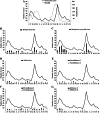The role of human bocavirus as an agent of community-acquired pneumonia in children under 5 years of age in Fortaleza, Ceará (Northeast Brazil)
- PMID: 35933553
- PMCID: PMC9679084
- DOI: 10.1007/s42770-022-00806-1
The role of human bocavirus as an agent of community-acquired pneumonia in children under 5 years of age in Fortaleza, Ceará (Northeast Brazil)
Abstract
The human bocavirus (HBoV) is an agent of upper and lower respiratory infections, affecting mainly children under 5 years of age. Community-acquired pneumonia (CAP) is an important public health problem in developing countries, representing one of the main causes of hospitalizations and deaths in children. The aim of this study was to describe the prevalence of HBoV and the clinical and epidemiological characteristics in children diagnosed with CAP. For this purpose, nasopharyngeal aspirates were collected from 545 children aged 0 to 60 months diagnosed with CAP between January 2013 and December 2014 in a reference pediatric hospital in Fortaleza, Ceará, Brazil. The samples were subjected to PCR for detection of HBoV and parainfluenza 4 (PIV4) and indirect immunofluorescence for detection of respiratory syncytial virus (RSV), adenovirus (AdV), influenza A and B (FLU A and FLU B), and parainfluenza 1, 2, and 3 (PIV1, PIV2, PIV3). Clinically, most CAP were non-complicated (487/545; 89.3%); however, 10.7% (58/545) of children were treated in the ICU/resuscitation sector. Among the total samples analyzed, 359 (65.8%) were positive for at least one virus surveyed and 105 (19.2%) samples had two or more viruses. HBoV was detected in 87 samples (15.9%), being the second most prevalent virus. RSV, AdV, FLU A, FLU B, and PIV 1-3 were detected in 150 (27.5%), 45 (8.2%), 30 (5.5%), 3 (0.5%), and 131 (24%) samples, respectively. The age average was 12.1 months in children infected with HBoV, and the most frequent symptoms were dyspnea and cough. In addition, 90.6% of HboV-positive children received antibiotics as empirical treatment. HBoV did not show any circulation pattern; however, it seemed to be more frequent in the first half of the year, totaling 68.9% of the cases. HBoV is a frequent agent of pneumonia in the child population studied.
Keywords: Children; Community-acquired pneumonia; Epidemiology; Human bocavirus; Respiratory viruses; Viral pneumonia.
© 2022. The Author(s) under exclusive licence to Sociedade Brasileira de Microbiologia.
Conflict of interest statement
The authors declare no competing interests.
Figures



Similar articles
-
Human bocavirus infection diagnosed serologically among children admitted to hospital with community-acquired pneumonia in a tropical region.J Med Virol. 2012 Feb;84(2):253-8. doi: 10.1002/jmv.22268. J Med Virol. 2012. PMID: 22170545
-
[Determination of the frequency of human bocavirus and other respiratory viruses among 0-2 years age group children diagnosed as acute bronchiolitis].Mikrobiyol Bul. 2014 Apr;48(2):242-58. doi: 10.5578/mb.7575. Mikrobiyol Bul. 2014. PMID: 24819262 Turkish.
-
Human bocavirus in children with respiratory tract infection in Shanghai: a retrospective study.World J Pediatr. 2010 Feb;6(1):65-70. doi: 10.1007/s12519-010-0009-2. Epub 2010 Feb 9. World J Pediatr. 2010. PMID: 20143214 Free PMC article.
-
[Human bocavirus infections in Spanish 0-14 year-old: clinical and epidemiological characteristics of an emerging respiratory virus].An Pediatr (Barc). 2007 Sep;67(3):212-9. doi: 10.1016/s1695-4033(07)70609-4. An Pediatr (Barc). 2007. PMID: 17785157 Free PMC article. Spanish.
-
The prevalence of human bocavirus in <2-year-old children with acute bronchiolitis.New Microbes New Infect. 2020 Aug 3;37:100736. doi: 10.1016/j.nmni.2020.100736. eCollection 2020 Sep. New Microbes New Infect. 2020. PMID: 32983545 Free PMC article. Review.
Cited by
-
Human Bocavirus in Childhood: A True Respiratory Pathogen or a "Passenger" Virus? A Comprehensive Review.Microorganisms. 2023 May 9;11(5):1243. doi: 10.3390/microorganisms11051243. Microorganisms. 2023. PMID: 37317217 Free PMC article. Review.
References
-
- Pneumonia. World Health Organization. 2019. (available in: https://www.who.int/news-room/fact-sheets/detail/pneumonia). accessed in 01/18/2021.
MeSH terms
LinkOut - more resources
Full Text Sources
Medical
Miscellaneous

